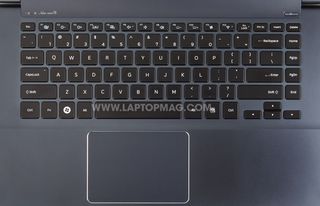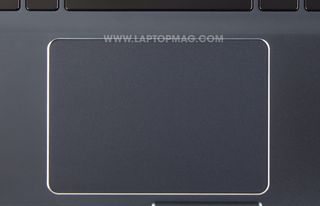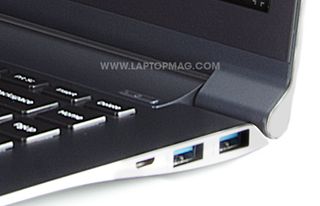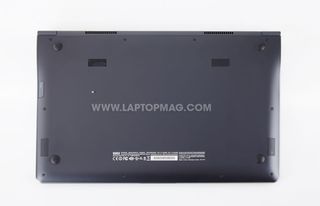Laptop Mag Verdict
The Samsung Series 9 15-inch (NP900X4C) improves upon the original 15-inch Series 9 in almost every way.
Pros
- +
Very thin and light
- +
Bright, crisp 1600 x 900 display
- +
Good audio
- +
Quick boot time
- +
Long battery life
Cons
- -
Shallow key travel
- -
Very slow SSD transfer speeds
Why you can trust Laptop Mag
When we first reviewed the $1,499 Samsung Series 9 15-inch Ultrabook, we marveled at its slim and light design, spacious 1600 x 900 display, fast boot time and long battery life. However, the speakers sounded a bit flat, and the keyboard and touchpad didn't impress. The latest model of the Series 9 15-inch, the $1,399 NP900X4C, features the same svelte design and adds an updated Ivy Bridge Core i5 CPU--all for $100 less than the original. How much better is this refresh?
Design

Click to EnlargeWhy fix something that isn't broken? The NP900X4C looks just like the previous ultraslim 15-inch Series 9. The notebook sports the same fingerprint-resistant, bluish-gray aluminum unibody and graceful, tapered design. Measuring 14 x 9.3 x 0.58 inches and weighing a mere 3.8 pounds, the NP900X4C remains the slimmest and lightest 15-inch notebook on the market, edging out the $599 HP Envy Sleekbook 6z (0.78 inches thick, 4.8 pounds). The MacBook Pro with Retina Display is also considerably heavier and thicker (4.5 pounds, 0.71 inches).
MORE: Samsung Best and Worst Notebook Brands 2013 Rating
Keyboard and Trackpad

Click to EnlargeThe keyboard and touchpad remain virtually unchanged on the 15-inch Series 9. The travel of the keys is still shallow, and although we were able to achieve a rate of 68 words per minute with an error rate of 1 percent on the Ten Thumbs Typing Test (slightly above our average speed), the island-style keys offered only a mediocre amount of tactile feedback.
Thankfully, Samsung has improved the backlighting. In a completely dark room, we were able to clearly make out individual keys, although the 400-nit SuperBright display illuminated the keyboard so thoroughly that the backlighting seemed almost superfluous.

Click to EnlargeThe 4.3 x 2.9-inch touchpad is just as spacious as before, and features much improved performance. The cursor glided smoothly and accurately across the screen, and clicks registered throughout the surface of the pad, rather than just the lower third. Multitouch gestures such as pinch-to-zoom and three-finger-swipe proved equally reliable.
Display

Click to EnlargeThe Series 9's 15-inch 1600 x 900-pixel matte display is nearly as bright as its predecessor, registering 368 lux on the light meter to the old 15-inch Series 9's jaw-dropping 399 lux. The XPS 15's fabulous 1920 x 1080p display came close at 323 lux, while the Sleekbook 6z's 1366 x 768 screen registered a meager a 149 lux. The average ultraportable sports a brightness of 232 lux.
A 1080p trailer for "The Dark Knight Rises" looked suitably dark and menacing. Details such as the sweat on Bane's skin stood out in sharp relief, and the bright oranges and reds of billowing explosions popped off the screen. We noticed a bit of pixelation in darker scenes, but not enough to distract the eye.
MORE: 5 Best Samsung Laptops
Audio
Watching the trailer for "The Dark Knight Rises" proved as much of an auditory experience as a visual one. Turning up the volume to the maximum, Hans Zimmer's swelling orchestral track filled the room. With no subwoofer, the Series 9 lacks some of the "oomph" of thicker notebooks such as the XPS 15, but it manages to maintain accuracy even at full volume.

Click to EnlargeSamsung's SoundAlive software allows users to adjust equalizer settings manually or using presets. We found the presets helpful in certain circumstances - "3D Depth," for instance, gives the impression of surround sound when listening to music at 50 percent volume, but distorts the sound quality when the volume is at its maximum.
Heat
With the NP900X4C, Samsung managed to make the 15-inch Series 9 run just a bit cooler. After streaming video for 15 minutes, the touchpad registered 78 degrees Fahrenheit (compared with 83 degrees on the previous generation), the space between the G and H keys was 90 degrees (previously 94 degrees) and the underside measured 92 degrees (previously 95 degrees). We consider anything above 95 degrees to be uncomfortable, and anything over 100 hot.
Ports and Webcam

Click to EnlargePort selection remains the same as on the previous Series 9 15-inch. The NP900X4C boasts two USB 3.0 ports, a powered USB 2.0 port and a 4-in-1 (rather than 2-in-1) card reader.
The notebook also sports a micro Ethernet port (an adapter is included in the box), microHDMI port and mini-VGA port (no adapter included), as well as a combo headphone/mic jack.

Click to EnlargeUsing the bundled CyberLink YouCam software, the 1.3-MP webcam captures stills and video at a maximum resolution of 1280 x 1024, although video suffers from a bit of lag when filmed at this resolution. Still, the camera rendered colors accurately and crisply.
MORE: 10 Laptops with the Longest Battery Life
Performance
The biggest change for the 15-inch Series 9 is found under the hood. The NP900X4C features an upgraded Ivy Bridge 1.7-GHz Core i5-3317U processor--combined with 8GB of RAM and 128GB SSD, as before--that delivers mostly improved performance. On PCMark07, a synthetic benchmark that measures overall processing power, the notebook notched a score of 3,749, beating the previous iteration of the Series 9 15-inch by 100 points and the ultraportable average by nearly 1,000.
By comparison, the Dell XPS (2.1-GHz Core i7-3612QM CPU, 8GB of RAM and 2GB Nvidia GeForce GT 640M GPU) scored 3,599. The much cheaper HP Envy Sleekbook 6z (2.1-GHz AMD A6-4455M APU, 4GB of RAM and 2GB AMD Radeon HD 7500G GPU) racked up a meager 1,400.
Unfortunately, Samsung seems to have exchanged the high-speed SSD in the older 15-inch Series 9 with a much slower SanDisk U100 SSD. The NP900X4C copied 5.04GB of mixed multimedia files in 2 minutes and 31 seconds, for a rate of just 33.7 MBps. That's more than 100 MBps slower than the old Series 9, which boasted a lightning-fast transfer rate of 154.2 MBps, and almost 20 MBps slower than the category average (50.8 MBps).
This speed was on a par with the 37.1 MBps turned in by the XPS 15 (750GB, 7,200-rpm HDD with 32GB SSD cache) and beats the 18.8 MBps achieved by the Sleekbook 6z (500GB, 5,400-rpm HDD), but those notebooks use spinning hard drives, not SSDs.
We tested two Samsung Series 9s, both with SanDisk SSDs, and saw similar results. However, Samsung told us that consumers who buy this system might not necessarily receive the same SSD. According to a press representative, Samsung chooses "multiple SSD suppliers in order to maintain a diverse supply chain to meet the demand and performance of our Series 9 units."
On the OpenOffice spreadsheet macro test, the NP900X4C matched 20,000 names and addresses in 5 minutes and 48 seconds, faster than the old Series 9 15-inch (7:04), the ultraportable average (8:12) and the Sleekbook 6z (9:10). The XPS 15 proved faster, completing the test in just 4 minutes and 54 seconds.
Boot and Wake Times
Despite its poor transfer speeds, the NP900X4C's SanDisk SSD allowed it to boot into Windows 7 in just 23 seconds. That's slower than the previous Samsung's blink-and-you-might-miss-it 16-second time, but it's still 20 seconds faster than the average ultraportable notebook (45 seconds), the Dell XPS 15 (46 seconds) and the HP Envy Sleekbook 6z (43 seconds).
Like before, the NP900X4C wakes from sleep in about 2 seconds - about the same wake time we've found on other Ultrabooks.
Graphics Performance
Thanks to its Intel HD Graphics 4000 chip, the NP900X4C features much better graphics performance than its predecessor. Playing "World of Warcraft" on Good settings and native resolution, the notebook averaged 43 frames per second, compared with just 30 fps on the old Series 9 15-inch. Turning up the graphics to Ultra caused the frame rate to drop to an unplayable 21 fps. Still, the previous model achieved only 14 fps using the same settings.
By comparison, the Dell XPS 15, which sports an Nvidia GeForce GT 640M GPU with 2GB of VRAM, notched 57 fps on "World of Warcraft" with the settings maxed out at 1080p. The Acer TimelineU M5, which has the same GPU as the XPS 15, also bested this Samsung (137 fps at 1366 x 768) but with a lower-res 1366 x 768 display. The HP Envy Sleekbook 6z and its AMD Radeon HD 7500G GPU with 2GB of VRAM managed only 18 fps.
Battery Life

Click to EnlargeAlthough you still can't remove the battery in the NP900X4C, it offers great endurance. On the LAPTOP Battery Test, which involves continuously surfing the Web over Wi-Fi, the notebook lasted 7 hours and 29 minutes, exactly 30 minutes longer than old 15-inch Series 9 and 39 minutes longer than the ultraportable category average. Among the competition, the Sleekbook 6z came closest (6:18), while the XPS 15 fell more than two hours short (5:07). The Acer TimelineU M5 lasted 7:29, identical to the Samsung.
Software and Warranty

Click to EnlargeThe NP900X4C comes preloaded with much of the same software and Samsung Utilities as on the previous model of the 15-inch Series 9. Samsung Easy Settings allows users to adjust battery settings, display and audio properties, keyboard backlighting and other settings. Easy Software Manager downloads and installs updates and drivers, while Easy Support Center can run checks on the notebook's hardware to ensure that it's running at optimal speeds.
Third-party software includes Microsoft Office Starter 2010, a 30-day trial of Norton Internet Security and Skype.
The NP900X4C comes with a standard one-year warranty. See how Samsung fared in our annual Tech Support Showdown and Best & Worst Brands report.
Verdict

Click to EnlargeAlthough we're disappointed with Samsung's decision to downgrade the 15-inch Series 9's SSD, the $1,399 NP900X4C boasts improved audio and retains the series' svelte design, beautiful 1600 x 900 display, fast boot time and long battery life, all for $100 less than the original. If you don't want to forgo discrete graphics, the Dell XPS 15 ($1,599) delivers excellent performance, solid frame rates and a breathtaking 1920 x 1080p screen, all wrapped up in an attractive (but bulkier) design. But if you're looking for the largest screen in the lightest package, the Series 9 15-inch is the way to go.
Samsung Series 9 15-inch (NP900X4C) Specs
| Bluetooth | Bluetooth 4.0 |
| Brand | Samsung |
| CPU | Intel Core i5-3317U |
| Card Slots | 4-1 card reader |
| Company Website | http://www.samsung.com |
| Display Size | 15 |
| Graphics Card | Intel HD Graphics 4000 |
| Hard Drive Size | 128GB |
| Hard Drive Speed | n/a |
| Hard Drive Type | SSD Drive |
| Native Resolution | 1600x900 |
| Operating System | MS Windows 7 Home Premium (64-bit) |
| Optical Drive | None |
| Optical Drive Speed | n/a |
| Ports (excluding USB) | mini-VGA, micro HDMI, Ethernet, Combo Headphone/Mic Jack, USB 3.0 |
| RAM | 8GB |
| RAM Upgradable to | 8GB |
| Size | 14.0 x 9.3 x 0.58 inches |
| Touchpad Size | 3.9 x 2.8 inches |
| USB Ports | 1 |
| Video Memory | 384MB |
| Warranty/Support | 1-year Limited Hardware Warranty |
| Weight | 3.8 pounds |
| Wi-Fi | 802.11a/b/g/n |
| Wi-Fi Model | Intel Centrino Advanced-N 6235 |
